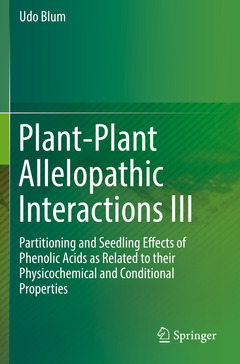Description
Plant-Plant Allelopathic Interactions III, 1st ed. 2019
Partitioning and Seedling Effects of Phenolic Acids as Related to their Physicochemical and Conditional Properties
Author: Blum Udo
Language: English
Subjects for Plant-Plant Allelopathic Interactions III:
Publication date: 08-2020
Support: Print on demand
Approximative price 105.49 €
In Print (Delivery period: 15 days).
Add to cartPublication date: 08-2019
Support: Print on demand
Description
/li>Contents
/li>Biography
/li>Comment
/li>
This volume continues the retrospective analyses of Volumes I and II, but goes beyond that in an attempt to understand how phenolic acids are partitioned in seedling-solution and seedling-microbe-soil-sand culture systems and how phenolic acid effects on seedlings may be related to the actual and/or conditional physicochemical properties (e.g., solubility, hydrophobicity, pKa, molecular structure and soil sorption/desorption) of simple phenolic acids. Specifically, it explores the quantitative partitioning (i.e., source-sink relationships) of benzoic and cinnamic acids in cucumber seedling-solution and cucumber seedling-microbe-soil-sand systems and how that partitioning may influence phenolic acid effects on cucumber seedlings. Regressions, correlations and conceptual and hypothetical models are used to achieve these objectives. Cucumber seedlings are used as a surrogate for phenolic acid sensitive herbaceous dicotyledonous weed seedlings. This volumewas written specifically for researchers and their students interested in understanding how a range of simple phenolic acids and potentially other putative allelopathic compounds released from living plants and their litter and residues may modify soil chemistry, soil and rhizosphere microbial biology, seedling physiology and seedling growth. In addition, this volume describes the potential relationships, where they may exist, for direct transfer of organic compounds between plants, plant communication and plant-plant allelopathic interactions and addresses the following questions: Can physicochemical properties of phenolic acids be used as tools to help understand the complex behavior of phenolic acids and the ultimate effects of phenolic acids on sensitive seedlings? What insights do laboratory bioassays and the conceptual and hypothetical models of laboratory systems provide us concerning the potential behavior and effects of phenolic acids in field systems? Whatpotential role may phenolic acids play in broadleaf-weed seedling emergence in wheat debris cover crop no-till systems?
Chapter 1. Reflections Regarding Plant-Plant Interactions, Plant-Plant Communications and Plant-Plant Allelopathic Interactions with an Emphasis on Plant-Plant Allelopathic Interactions.- Chapter 2. General Background for Plant-Plant Allelopathic Interactions.- Chapter 3. Conceptual Models for Soil Systems and Physicochemical Properties of Organic Compounds.- Chapter 4. Simple Phenolic Acids in Solution Culture I: pH and pKa.- Chapter 5. Simple Phenolic Acids in Solution Culture II: Log P, Log D and Molecular structure.- Chapter 6. Simple Phenolic Acids in Soil Culture I: Sorption, Kd and KOC.- Chapter 7. Simple Phenolic Acids in Soil Culture II: Biological Processes in Soil.- Chapter 8. Hypothetical Solution-Culture System Sub-Models.- Chapter 9. Hypothetical Soil-Culture System Sub-Models.- Chapter 10. Quantitative Hypothetical System Models for Cecil Soil-Sand Systems.- Chapter 11. Quantitative Hypothetical System Model for Portsmouth Soil-Sand System and Potential Modifying Factors.- Chapter 12. Epilog: Assumptions, Models, Hypotheses and Conclusions.




